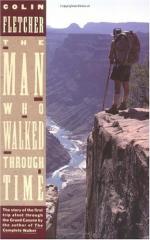|
This section contains 490 words (approx. 2 pages at 400 words per page) |

|
The Man Who Walked Through Time Summary & Study Guide Description
The Man Who Walked Through Time Summary & Study Guide includes comprehensive information and analysis to help you understand the book. This study guide contains the following sections:
This detailed literature summary also contains Topics for Discussion and a Free Quiz on The Man Who Walked Through Time by Colin Fletcher.
The Man Who Walked Through Time by Colin Fletcher is a work of non-fiction detailing the author's trek through the Grand Canyon during a two month period. The book divided into four main parts. It begins with the first part, "The Place." In this short chapter, Fletcher begins by telling some facts about the Grant Canyon. Fletcher states, "The Grand Canyon of Colorado is a chasm that slices through the plateau country of northern Arizona like a gigantic and impossible desert crevasse" (p. 3).
Geologists once believed that the Grand Canyon was formed by the Colorado River over a period of millions of years. The author explains how the Colorado River's course was disrupted, and instead of diverting its path, the river stayed its course and burrowed into the soil and rock. This process continued for about seven million years until the Grand Canyon was formed. The Colorado River still runs through a large portion of the canyon, although in many if not most parts, it is calmer than it was during the height of the process.
The book begins with the first part, "The Place," in which Fletcher details valuable and informative information about the Grand Canyon and its formation.
The second part, "The Dream," describes an impromptu side trip made to the Grand Canyon during a cross country journey with a friend. Fletcher had never seen the Grand Canyon and felt it was imperative to do so. That side trip would spark the dream that would change Fletcher's life. It also details Fletcher's plans and study regarding the Grand Canyon and the trip he planned to make alone.
Fletcher gives some background information on his lifestyle as a "compulsive walker." Fletcher's only real concern was if the trip was physically possible. The author was in great physical condition, but it was imperative to know if there were places that would block his path, such as the Colorado River, which is impassable in some parts, or the hanging terraces, as Fletcher calls them, narrow sloping ledges impossible or at least highly dangerous to climb or traverse. The questions asked by Fletcher at the Grand Canyon National Park Office were practical and did not reflect anything beyond the most necessary information regarding trails, weather, and existence of water sources. Fletcher shares some of the information gained from Park officials.
The third part, "The Journey," is the longest. It details Fletcher's trip from the Grand Canyon National Park Office to the other side and includes a great amount of rich detail of the canyon and its inhabitants as well as Fletcher's own personal journey.
The fourth part, "Epilogue," regards the present and future of the Grand Canyon. Fletcher believed that the Grand Canyon may change drastically for the worse, due to proposed projects by the government, making the book a requiem for what it was at one time. To date, that has not happened, but the possibility remains.
Read more from the Study Guide
|
This section contains 490 words (approx. 2 pages at 400 words per page) |

|



